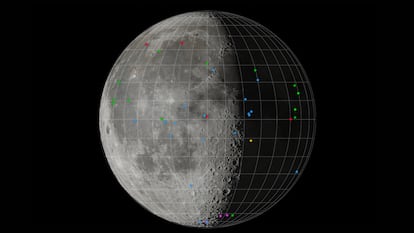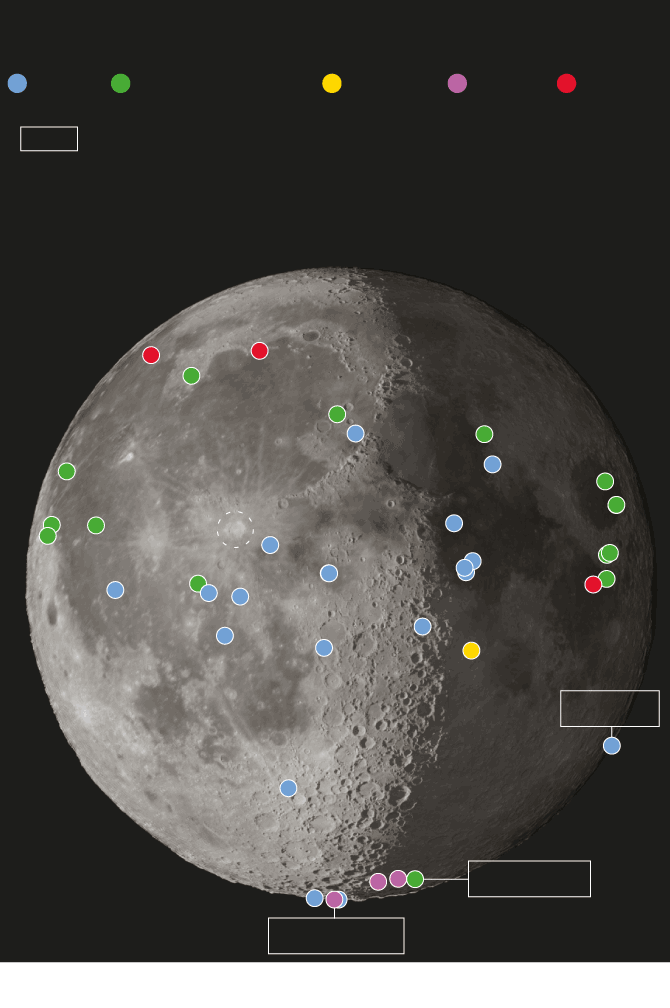World race to the seventh continent: the Moon
Russia and India are vying to be the first to reach the satellite’s south pole as the United States prepares a crewed mission that is set to land in 2025

The Moon will be the seventh continent of the Earth, the only one whose riches and resources are yet to be conquered and exploited. This idea, formulated more than half a century ago in the Soviet Union (the Russians consider Eurasia a single continent), has been revived with the imminent arrival of the first missions to the south pole of the Moon. Here, the space powers will compete for the new lunar gold: water.

Moon landings by country
USA
USSR / Rusia
Japan
India
China
Location for future missions
Orthographic view of the
visible face of the Moon
Sea of
Serenity
Copernicus
crater
Sea of
Clouds
VIPER
Moon-25
Artemis 3
Source: NASA, Roscosmos, JAXA, CNSA.

Moon landings by country
USA
USSR / Rusia
Japan
India
China
Location for future missions
Orthographic view of the
visible face of the Moon
Sea of
Serenity
Copernicus
crater
Sea of
Clouds
VIPER
Moon-25
Artemis 3
Source: NASA, Roscosmos, JAXA, CNSA.

Moon landings by country
Japan
USA
India
USSR / Rusia
China
Location for
future missions
Orthographic view of the
visible face of the Moon
Chang'e 3
Chang'e 5
Moon 17
Moon 2
Sea of
Showers
Sea of
Serenity
Moon 21
Apollo 15
Moon 13
Moon 15
Apollo 17
Copernicus
crater
Ranger 6
Moon 8
Moon 7
Moon 24
Surveyor 2
Moon 18
Ranger 8
Moon 20
Moon 9
Surveyor 6
Apollo 11
Moon 5
Surveyor 3
Moon 16
Surveyor 5
Apollo 14
Chang'e 1
Surveyor 1
Apollo 16
Apollo 12
Sea of
Fecundity
Ranger 7
Ranger 9
Slim
Sea of
Clouds
VIPER
Surveyor 7
Chandrayaan 2
Moon-25
Chandrayaan 1
LCROSS
Chandrayaan 3
Artemis 3
Many missions
Source: NASA, Roscosmos, JAXA, CNSA.
Russia has announced that its probe Luna-25, the first the country has sent to the Moon in more than 40 years, will land between August 21 and 24. India’s Chandrayaan-3 will land on the Moon on August 23 or 24. The battle for who makes it first will come down to a matter of days, or even hours.
“We will wait for the 21st,” said Yuri Borisov, the chief of the Russian space agency, in a statement reported by Reuters. The landing at the pole will be completely automatic, and a lot depends on the probe reaching the predetermined zone, which is a little uneven. “I hope that a highly precise soft landing on the moon will take place,” added Borisov. “We hope to be first.”
Russia’s main advantage is that its spacecraft is able to hold out at the hostile south pole for a year or more. The probe will remain fixed at its landing point, north of the Boguslavsky crater, which is 60 miles (97 kilometers) in diameter. This is where there is a high probability of finding water.
“If there is frozen water in the upper layer of the lunar surface near the landing site, the scientific instruments on board Luna-25 will be able to detect it,” Olga Zakutniaya, spokesperson for the Institute of Russian Space Research (IKI), who is responsible for the scientific part of the mission, tells EL PAÍS. “However,” she continues, “even in its polar regions, our satellite is a very dry place compared to Earth. The Russian LEND instrument aboard NASA’s [orbital probe] LRO has shown that the water content in the upper layer of the surface, down to a depth of one meter, does not exceed 5% in weight, but only in the regions that are richest in water. The average content is lower and the regions with the greatest presence of water are unevenly distributed.” This poses major challenges for the future when it comes to finding ways to harness that water to generate hydrogen for fuel, oxygen for breathing, drinkable water.
If the Luna-25 manages to land successfully, the experiments will begin immediately, but the results will take between four and six months, explains Zakutniaya. The ship must hibernate during the frigid lunar nights, which last just over 14 Earth days. These results will also provide another key piece of information. “Lunar dust is extremely harmful both for robotic probes and future astronauts, so with the data from this mission we will develop plans to combat its effect,” says the IKI spokesperson. Russia plans to send successive robotic missions to the Moon’s south pole to lay the groundwork for the arrival of astronauts, a project that has not yet been approved by the Putin government.

The race to reach the south pole is David and Goliath battle, with India the clear underdog. The Indian probe Chandrayaan-3 is carrying fewer scientific instruments and will only run until the sun sets after the first lunar day. Unlike Russia, which has already managed to land robotic spacecraft on the Moon, India is coming out of the failure of Vikram, a lander that was traveling on board the orbiter Chandrayaan-2 in 2019 and failed to land successfully. Authorities at the Indian Space Research Orgnisation (ISRO) say they have learned from their mistakes and hope that this time the spacecraft will land successfully at a speed similar to that of a person walking. Its great asset is that he has on board the Pragyan (meaning wisdom in Sanskrit), a small mobile vehicle that will allow it to explore the environment near the landing point at the south pole, and analyze the composition of the soil and the rocks.
The Indian space agency says that there are already six orbital probes in use on the Moon and another two that have been abandoned. According to the agency, Chandrayaan-2 has already had to perform three maneuvers to avoid collisions with other ships. The Indian team hope that as the Moon is filled with more ships, both public and private, there will be better coordination to avoid these “risks.”
Just as Russia and India are fighting to be the first to land at the south pole, Japan will join the race by launching its Slim mission, a small device developed by the Japanese space agency that is scheduled to take off on August 26. In this case, its goal is to land far from the pole, in the equatorial zones of the Moon.
The highlight of the lunar gold rush is the crewed mission to the Moon, set to be launched by the United States and its allies. Earlier this week, the head of NASA, Bill Nelson, gave a press conference that seemed designed to coincide with the launch of the Russian mission Luna-25, which was carried out successfully on Friday. His main message was that the dates for the manned Artemis 2 and 3 missions have not been changed, despite the fact that the rocket needed for one of them, SpaceX’s Starship, blew up on its first test. Artemis 2, which will be crewed by three Americans and one Canadian, will depart in late 2024 for a flyby of the Moon. The next mission, set for December 2025, will see the first woman and first Black astronaut set foot on the Moon, 50 years after the first crewed missions to the satellite. The goal is to land at the south pole.
Nelson agrees that there is a space race, although says America’s main rival is not Russia or India, but China. “I don’t want China to get to the south pole first with humans, and then say, ‘This is ours, stay out,’” said Nelson, who is a former member of Congress. Through the Artemis accords, the United States is establishing itself as the world arbitrator that will monitor that the resources of the Moon are accessible to all signatories. So far, 28 countries have signed the accords. Despite the Ukraine war and his distance from the Putin regime, Nelson was surprisingly supportive of the Russian mission. “We wish them luck,” he said of Luna-25.
In 2024, NASA also hopes to launch several robotic missions, including a mobile exploration rover, that will pave the way for astronauts and the Artemis Base Camp, the first human settlement on the south pole of the Moon. From there, the astronauts will explore the environment using different mission-conditioned vehicles, first for several days and later for weeks. It will be the start of public-private projects that will be developed this decade, and begin the exploitation of water and minerals on the Moon. Lunar surface and orbital bases will be the test sites for future missions to Mars, with a one-way trip lasting a year.
Veteran Russian scientist Mikhail Marov, a specialist in exploration of the solar system, hoped that space exploration may lead to greater global cooperation. “One hundred and twleve years ago, in 1911, the study of the Earth’s south pole began,” he wrote in a special issue of the Astronomical Bulletin magazine dedicated to Luna-25. “Half a century later, Antarctica is home to several thousand people from almost 30 countries, who constantly carry out large-scale scientific research there. In the modern era, the beginning of the development of the south pole of the Moon may become an analogue of this process.”
Sign up for our weekly newsletter to get more English-language news coverage from EL PAÍS USA Edition

